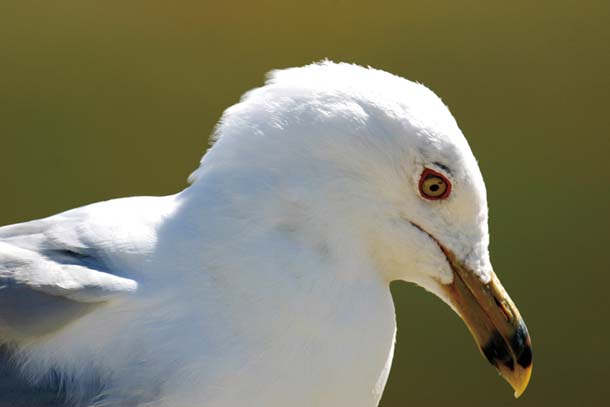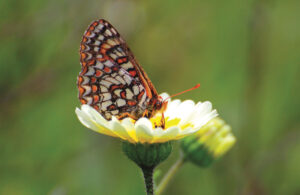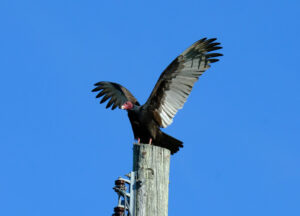Years ago, I knew a man who had figured gulls out. There were two kinds of gulls on San Francisco Bay, he said: the white kind and the brown kind. The brown gulls were more aggressive. He was so proud of this insight that I never had the heart to tell him how wrong he was.
In fact, a dozen species of gulls inhabit the Bay, its fringing wetlands, and nearby ocean waters at one time of year or another. Two, the western gull and the California gull, nest here and we see them year-round. Others are either winter or summer visitors, and a few appear only as occasional strays.
So we see a lot of gulls, and familiarity breeds contempt. Most nonbirders consider them about as interesting as pigeons. Yet the challenging field identification of gulls has become the focus of a whole school of extreme birding, with a couple of hefty books devoted to the subject. And no wonder: Typical gulls go through multiple molts; younger birds (the “brown gulls”) don’t look much like adults (the “white gulls”), and the larger gulls may take up to four years to attain full adult plumage. Then there are the hybrids to contend with.
That said, it’s easy enough to sort gulls out into a few broad categories: First, there are the big white-headed, pink-legged gulls like the year-round western gulls and winter-resident glaucous-winged, herring, and Thayer’s gulls. Then, we have three species of mid-size white-headed gulls with yellow or greenish legs and herring-gull-type wing patterns: the resident California gull and two regular winter visitors, ring-billed and mew gulls. In a category of its own is the dark-bodied Heermann’s gull, a summer visitor that follows brown pelicans up from the Sea of Cortez and pirates fish from them. The smallest of our regular gulls, the Bonaparte’s, is a winter visitor that, unusually for gulls, nests in trees and doesn’t feed at landfills.
Gulls as such go back some 15 million years in the fossil record. Our understanding of gull evolution is still a work in progress. One recent study, applying the idea of genetic bar coding to North American birds, found that seven of the big white-headed gulls were barely distinguishable as species; their bar code genes were 99.8 percent identical. That suggests a recent common origin. Some species, including the western and glaucous-winged, interbreed freely where their ranges overlap.
Worldwide, 50 or so recognized gull species inhabit every continent except Antarctica. Hardy, adaptable birds, they survive on North Polar ice floes and in the scorching Atacama Desert of South America. Mostly they frequent coastlines and interior wetlands. Very few have established themselves on oceanic islands: Hawai’i, for example, has no native gulls.
These birds owe much of their success to the fact that there’s little they won’t consider eating. Some eat brine shrimp, grasshoppers, seal afterbirths, fish, squid, carrion, small mammals, and the eggs and chicks of other seabirds–even those of their own kind. Others feed at landfills, exploiting the waste we generate.
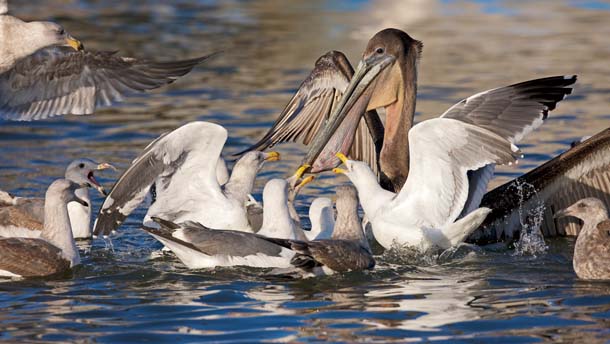
- Size doesn’t necessarily matter to these western gulls, seen here harassing a much larger brown pelican. Photo by Rebecca R Jackrel.
“Much that is good and all that is evil has gathered itself up into the Western Gull,” wrote ornithologist W. L. Dawson in his 1923 classic Birds of California. He praised the bird’s handsome plumage, but warned that it belied “the black heart within”–“Cruel of beak and bottomless of maw . . . this gull asks only two questions of any other living thing: First, ‘Am I hungry?’ (Ans., ‘Yes.’) Second, ‘Can I get away with it?’ (Ans., ‘I’ll try.’)”
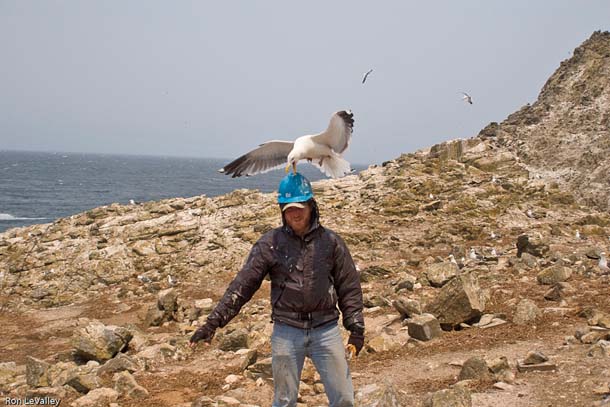
- Pete Warzybok from PRBO Conservation Science braves the assault of a western gull during breeding season on the Farallones. Photo by Ron LeValley, courtesy PRBO Conservation Science.
Scientists today use more measured language in describing the western gull. When you talk to people who have spent time with westerns in the field, though, it’s clear that this is a bird with a strong personality.
“Western gulls can be very challenging,” says PRBO Conservation Science biologist Russell Bradley, who studies them at the Farallon National Wildlife Refuge. “Early in spring they’re not interested in you. Once they have eggs they’re very aggressive. Once they have chicks, even more so. We have to wear hard hats outside. They hit you in the head with their full body. I’ve been knocked to the ground by gulls. They’ll come up and scream in your ear as they’re crapping on you.” Bradley recalls one “really mean gull” that would run up behind biologists and bite their Achilles tendons.
This is not just generic crankiness, either. Western gulls can recognize and target individual humans. “They recognize individuals even within a small group of people,” says researcher Raymond Pierotti. In 1980, PRBO’s Larry Spear incurred the wrath of westerns on Southeast Farallon Island by trapping and rebanding adults. When the birds’ distress over his presence threatened to disrupt research operations, Spear resorted to a disguise, which included a green-faced, orange-haired Halloween mask and an unfamiliar broad-brimmed straw hat. This seemed to mollify the birds–until he took the mask off, when full-scale panic ensued. The gulls held their grudge into the following breeding season. “My own ability to identify gulls by reading their band numbers seemed crude in comparison,” Spear wrote.
For researchers on Southeast Farallon, being gull-bombed is just part of the day’s work. Human-gull interactions at a tourist destination like Alcatraz can be more problematic. National Park Service biologist Lara Rachovitz says it’s been necessary to destroy or move nests in heavily visited areas: “We either take the eggs or move the nests into areas less impacted by people. We’ve also used wires to create an unstable environment to prevent them from nesting.”
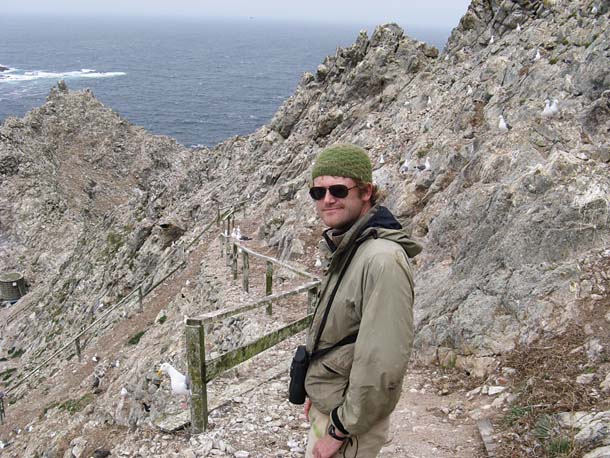
- Russ Bradley says the westerns are surprisingly vulnerable, since more than a third of the global population nests on Southeast Farallon Island. Photo by David Loeb.
Westerns don’t spare their own kind. Struggles for territory are particularly intense on Southeast Farallon, where nesting space is at a premium. They claim their sites in early spring. “They have to fight the other gulls,” Bradley explains. “It’s brutal. Most people would be shocked at how hard it is to maintain a territory. We observed one fight that lasted 45 minutes and left both birds covered with blood.” Males, larger and more aggressive than females, bear the brunt of the combat. Once settled on a territory, western gulls will attack anything that enters it, avian or human. This can be fatal for smaller seabirds like Cassin’s auklets and ashy storm-petrels that blunder into a gull’s domain–or for a neighbor’s wandering chicks.
Western gulls on the Farallones have a varied diet. Though they’re primarily fish-eaters, their ability to exploit other food sources buffers them when fish stocks are low, while other colonial seabird populations crash. Staples include anchovy, mackerel, juvenile rockfish, squid, krill, and barnacles. When Southeast Farallon had a feral rabbit population, the gulls hunted rabbit. They’ll also take the eggs and chicks of other species, notably common murres and Brandt’s cormorant. “As an egg-thief and as a kidnapper of infants, the Western Gull is simply incorrigible,” wrote Dawson. “Two gulls will tag-team a nesting murre,” says Bradley. “One pulls the murre off the nest, the other grabs the egg.” Spear describes specialist gulls, all males, that held feeding territories among the murres and cormorants and preyed on their chicks and eggs. They and their mates produced more young than nonspecialists did, especially during an El Niño year.

- Landfills are a gull smorgasbord, supporting many more birds than natural food sources would alone. Photo by Nina Zhito.
Gulls being gulls, garbage is also on the menu. Bradley saw one western regurgitate “a full Burger King wrapper with the fries still inside.” The gulls Pierotti and fellow researcher Cynthia Annett studied on Alcatraz ate a lot of chicken parts discarded by crab fishers. The scientists found that nesting pairs switched from trash to fish when their chicks hatched. The chicks’ peeping calls from inside the shell triggered the transition. As Annett explains it, garbage is a dependable but low-quality food source. “Fish, in contrast, are a very high-quality food source,” she says. “They have all the minerals breeding females require for eggshell production, plus a suite of amino acids. They’re a complete diet source for chicks.” Chicks reared on a steady diet of garbage grow more slowly and have higher mortality rates than fish-fed chicks, and gulls that persist in bringing home trash have lower lifetime reproductive success than fish specialists.

- A western gull chick at Natural Bridges State Beach near Santa Cruz begs for food from its parent. Research shows that chicks fed natural foods like fish or crab do better than those reared on garbage. Photo by Larry Selman.
Local western gull breeding populations have remained fairly stable over time, although recent years have seen declines. In 2010 an estimated 18,220 pairs nested on Southeast Farallon; counts in the early 1980s exceeded 25,000. Historically, that single island has hosted 30 to 40 percent of the species’ global population. Alcatraz had just over 700 pairs this year, down from last year’s 888 and a peak count just above 1,000 two years ago.
It’s hard to think of such an abundant species as being potentially in trouble. Their geographical concentration is worrisome, though. Pierotti, who has a fair amount of sympathy for these feathered devils, says the Farallon population, near major shipping lanes, is “extremely vulnerable” to oil spills and other disasters. Like the other creatures of the California Current, they’re also at the mercy of changing ocean conditions that are being driven by global warming.
When the battle to save Mono Lake heated up in the 1970s, one of its nesting birds became a conservation icon: the California gull, soaring symbol of imperiled wild landscapes. The gull, its Mono population at risk as water levels fell and predators gained access to island colonies, was listed as a California Species of Special Concern.
That was then. Today there’s less concern about the future of the California gull than about its impact as a predator of other waterbirds, including endangered California least terns and western snowy plovers. Since the Mono battle, California gull populations in the South Bay have exploded, presenting hard choices for wildlife managers and salt pond restoration planners.
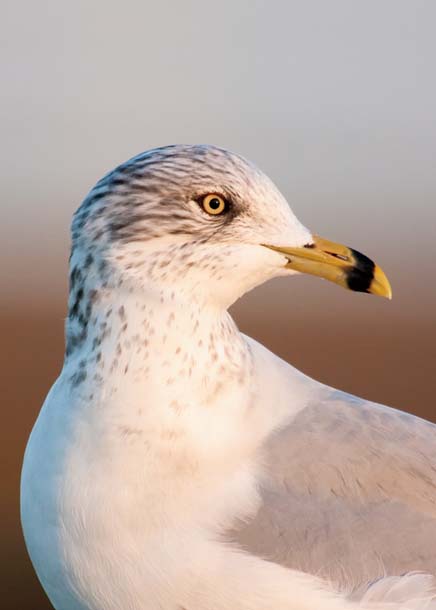
- Ring-billed gulls like this one are common at beaches and picnic areas. Photo by Hank Christensen.
Despite its name, the California gull historically nested at interior lakes, from Utah (where gulls famously saved the Mormon pioneers’ crops from a plague of grasshoppers) to the Northwest Territories. The species established a beachhead in the South Bay in 1980, with 24 nests. By 2008, the Bay’s breeding population had reached 46,000. This year’s estimate by San Francisco Bay Bird Observatory (SFBBO) biologists is 45,000–down a bit, but still a lot of California gulls. There are also small colonies on Southeast Farallon, Alcatraz, Brooks Island off Richmond, and, beginning this year, the first Central Valley outpost, in Yolo County.
I visited the largest colony, Pond A6 in the Don Edwards San Francisco Bay National Wildlife Refuge, in June with SFBBO’s Caitlin Robinson-Nilsen. “Pond” is misleading; A6 is mostly salt pan, transected by a channel and moated by rain-filled borrow pits left over from levee building. Biologists doing gull surveys have to make their way out along a rickety catwalk. A good proportion of the 23,000 A6 breeders were home the day I visited, with commuters coming and going. We watched new arrivals regurgitating food for their fluffy gray chicks–usually two to a nest, sometimes three, a couple of weeks old. A few adults were sitting tight, maybe brooding very young hatchlings.
“The gulls are pretty adaptable,” Robinson-Nilsen says. “They’ll nest on lumpy mud, in vegetation, or out on the dry salt pan. In Alameda they’re using an old runway. They can get really creative with nest material. We’ve seen nests made of chicken bones, plastic Easter basket grass, pens and pencils, even a Barbie leg. A lot of it they bring back from landfills. They also steal nesting material from each other.”
The nearby landfills are also a food source, though there’s no shortage of natural food: In addition to eating fish, the gulls feed heavily on the brine shrimp and brine flies that teem in the salt ponds. At A6, I watched one running along the shoreline with its mouth agape, scooping up flies as they swirled up from the mud. “The invertebrate community of the South Bay is a lot like Mono Lake’s,” says SFBBO director Jill Demers. “It’s easy to see why the birds are here. Brine flies especially are high-value food.”
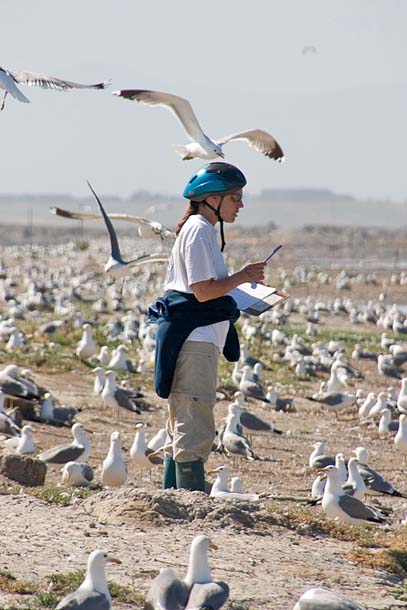
- Each spring, San Francisco Bay Bird Observatory biologists and volunteers survey the approximately 45,000 gulls that nest near Alviso. Photo by Rod Golden.
The dumps are easy pickings, and the gulls use them throughout the breeding cycle, although traffic drops off between April and August. Unlike the western gulls of Alcatraz, there’s no evidence yet that they switch foraging patterns when their offspring hatch. U.S. Geological Survey biologist Josh Ackerman has just launched a study of the gulls’ breeding-season diet to differentiate between garbage and natural marine foods. USGS teams have also been tracking California gull predation of American avocets, black-necked stilts, and other colonial waterbirds in the South Bay. “They’re voracious predators of shorebird chicks,” says Demers. In 2005 and 2006, biologists attached lightweight radio transmitters to avocet and stilt chicks and monitored their fates. At least 61 percent of the tagged avocet chicks and 23 percent of the stilt chicks were taken by gulls.
Meanwhile, SFBBO has used remote cameras to catch the gulls in the act of attacking western snowy plover nests. California gulls are also an issue at Hayward Regional Shoreline, where the East Bay Regional Park District is trying to establish a California least tern colony and maintain a snowy plover population. It’s possible that some individual gulls are specialist predators, like Spear’s western gulls on Southeast Farallon. If so, managers might have to kill some gulls, but large-scale culling isn’t an option, since they’re protected under the federal Migratory Bird Treaty Act.
Would reducing gulls’ easy access to landfill food keep their population in check? That’s being tried at Milpitas’s Newby Island facility. “We’re working with landfill managers to deter the gulls, using a mix of stuff,” says Robinson-Nilsen. Air Strike Bird Control has been hired to harass the gulls with trained falcons and Harris’s hawks, and dogs and fireworks are also being deployed. The mix has proven effective at that site, but the gulls may just be moving to other landfills–or increasing their take of shorebird and tern chicks.
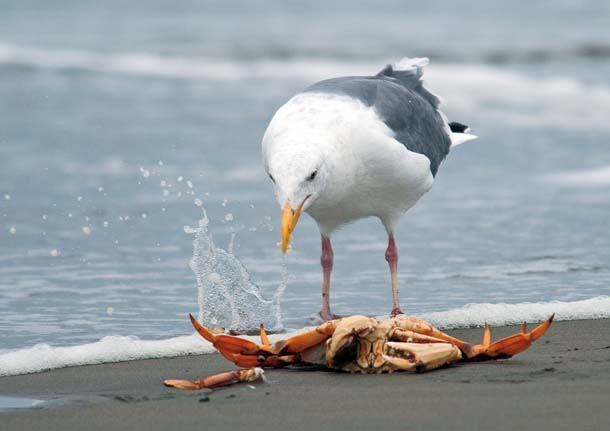
- This western gull dines on a Dungeness crab. Photo by John W. Wall.
A further complication: If the current schedule for salt pond restoration holds, A6 will be breached and flooded next year, displacing most of its California gull colony. Refuge biologist Cheryl Strong says patches of high ground in A6 will remain as potential nest sites until the pond silts in. Where the rest go, and how they impact other waterbird species, is a looming question. Some may move into other, currently smaller colonies, but space may be limited. To be able to track the diaspora, SFBBO biologists have been outfitting A6 breeding adults and nestlings with field-readable bands.
In the long run, some biologists think, South Bay gull and prey populations will reach equilibrium, especially if more landfill operators adopt abatement measures. “You’ll eventually see gull numbers go down if they’re food-limited,” says Demers. Others, like Ackerman, count on the creation of new habitat in the restored tidal marsh to accommodate waterbirds displaced by the gulls. Either way, gull predation of endangered species will remain a concern.
Raucous, rapacious, and downright inconvenient as they can be, you have to give gulls their due. “The more you work with them, the more respect you have for them,” Russell Bradley says of the Farallon westerns. Gulls as a group are tough birds, with a behavioral flexibility that enables them to thrive among humans as other species fade. Even Dawson had more than just harsh words: “One may forget his grudge and lose himself in admiration of the consummate grace and skill with which the birds address themselves to the tasks of breasting the wind or coasting down the gale.”

.jpg)
